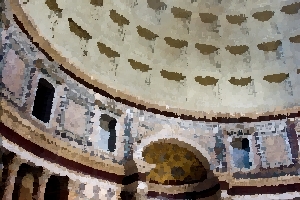The Roman Pantheon is now the best-preserved building in Rome and the oldest 'important' building in the world to still have an entirely intact roof. The building's design is attributed to Apollodorus of Damascus, a second-century Greek engineer and architect. While the method of construction of the Pantheon has never been determined, there is no doubt that it is a truly remarkable achievement.
Short History
 An old image-illustration of the Pantheon. [CC] credit.
An old image-illustration of the Pantheon. [CC] credit.The building of the Roman Pantheon was begun in 27 BC, commissioned by Marcus Vipsanius Agrippa. At that time, it was a classical temple with a gabled roof supported by a colonnade. This building was destroyed by fire in 80 AD, and between 118 and 128 AD, it was completely rebuilt by Hadrian, the Roman Emperor of that era. The Pantheon was originally built with adjoining water gardens and baths. However, these are no longer in existence. Various Roman Emperors made some minor repairs and alterations in the third century AD. However, the building as it can be seen today is, except for paintings added in the fifteenth century, almost identical to the building in the second century.
The word Pantheon is derived from Greek and literally means 'temple of the Gods. The original Pantheon was a temple dedicated to the seven deities of the state religion of Ancient Rome. However, since the seventh century, the Pantheon has been a Christian Church. In 609 AD, Emperor Phocas gifted the Pantheon to Pope Boniface IV, who consecrated the temple and dedicated it to St. Mary and all Christian martyrs. It was then renamed Santa Maria ad Martyres. The building is still in use as a church today and is used mostly for important masses.
During the Renaissance, the Pantheon came to be used as a tomb as well as a church. Italian painters Raphael and Annibale Caracchi are buried there and two Italian kings, Vittorio Emanuele II and Umberto I. Also, during this period, the Pantheon interior was decorated with paintings, the most well-known of which is the Annunciazione by Melozzo da Forli.
Architecture
 A 3d architectural representation of the Pantheon in Rome. [CC] credit.
A 3d architectural representation of the Pantheon in Rome. [CC] credit.The Pantheon, as it can be seen today, is a circular building, constructed primarily of concrete, with brick accents. The great dome that rises from the roof is made of concrete, as are the Corinthian columns form the front of the building and support the gabled roof. The engraved bronze double doors that serve as the Pantheon entrance are a massive seven meters high.
The dome measures 43 meters at its widest point and rises to 22 meters above its base (or 43 meters above the floor). At the top of the dome is an oculus—a circular opening about eight meters in diameter, which is the only light source for the building's interior. Except in the lowest part of the dome, there appears to be no evidence of any structural support for it. That the dome has remained intact and stable for well over 1500 years is a testament to both its exceptional design and the high quality of building materials used in its construction.
 Some arches, columns, artifacts and dome from within the Pantheon. [CC] credit.
Some arches, columns, artifacts and dome from within the Pantheon. [CC] credit.The vast interior of the Pantheon is a sharp contrast to the exterior, which, it must be admitted, looks rather plain. The lower parts of the interior are adorned with paintings and colored marble, and the sheer size of the room and its dome is awe-inspiring, particularly when you remember that it was constructed more than 1500 years ago. A visitor stepping inside the Pantheon for the first time will immediately notice a sense of warmth and light and a feeling of harmony that stems from the perfectly-proportioned dome—the diameter of the dome and the interior beneath it is exactly equal to the distance from the floor to the oculus.
Visiting information
The Pantheon is easy to find in Rome, lying between Piazza Navona and the Trevi fountain, and the surrounding streets are well-signposted. No booking is required, and entry to the Pantheon is free. Even if you prefer to stay clear of crowded tourist spots, the Pantheon is a must-see when you're in Rome. If you want to avoid the crowds, visit early in the morning or late in the afternoon.